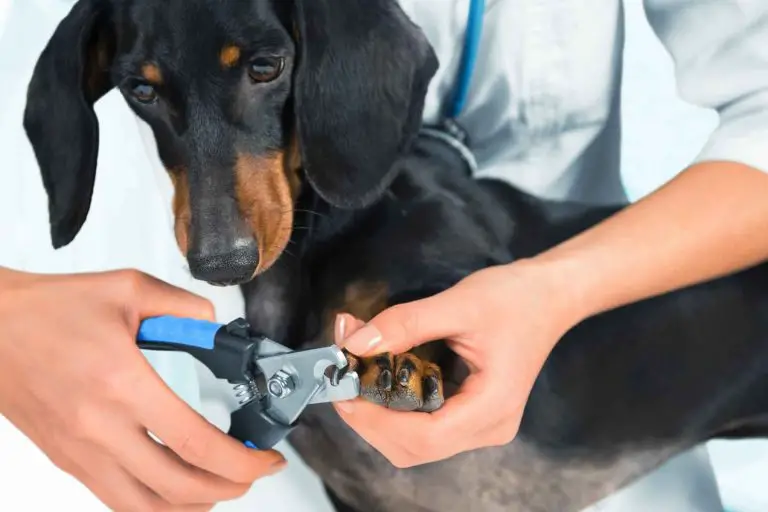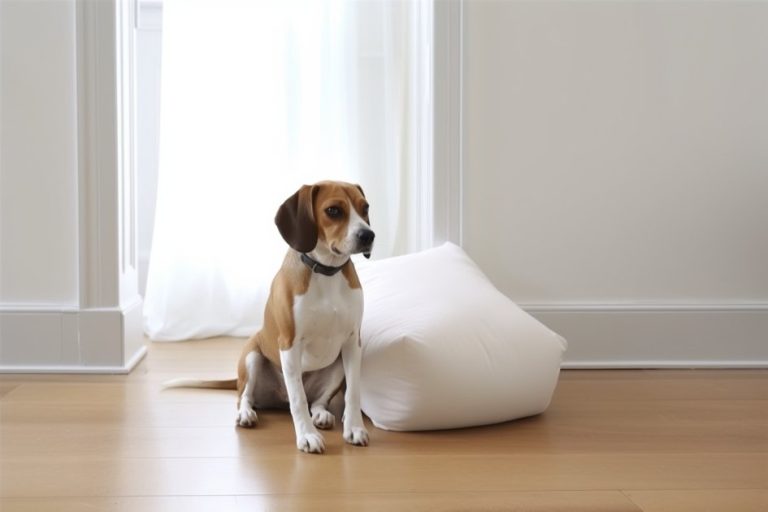Why Do Dogs Cross Their Paws?

If there’s anything you can count on as a dog owner, it’s that you’ll be in constant wonderment about your pet’s behavior. For example, what does it mean when your dog crosses their paws?
Thankfully, the reason your dog is crossing their paws is likely benevolent. They could be showing you how they feel, trying to get more comfortable, or simply enjoying the attention they’re receiving.
From habit formation to breed disposition, there are cues and points to keep in mind when it comes to this regal-looking behavior! Discover those and other meanings behind your dog crossing their paws in this article.
A Dog Crossing Their Paws To Convey Peace
We are waiting for the invention of a dog collar like Dug’s from Up– one that can seamlessly translate each of our fur babies’ whines and barks, but until then, we’ll have to make do with paying close attention to their behaviors.
Though it may sometimes be hard to believe, your fur baby is a direct descendant of the gray wolf.
We’ve bred a lot of their wild behaviors out, but some things, like the meanings behind the positions they relax in, are directly correlated to their ancestors. The main thing to keep in mind is that, if they feel unsafe, your dog won’t lay in too relaxed a position.
Now, paw crossing can inhibit dogs from getting up too quickly. It gives them one more step to do before they rise to investigate potential dangers: unfold paws and then stand.
In an environment where there are a lot of stressors or reasons for your dog to stay alert, letting their guards down by being in a compromising position is the last thing they’ll do.
However, if you’ve cultivated a home that feels safe, or if your dog senses a distinct lack of worry, they will allow themselves to be in softer positions: laying on their side, back, and of course, crossing their paws.
Here are other telltale cues your dog will give you to show their happiness, as described by ‘AnimalWise’ on Youtube:
A Dog Crossing Their Paws to Convey Nervousness
Anxiety can physically manifest in dogs in multiple ways. This can range from nibbling at themselves to being uncharacteristically vocal or overly quiet.
It’s important to note that no two dogs will showcase their nerves in the same way. As an owner, make it a habit to take notice of your pup’s demeanor in stressful situations so you can better understand them.
Due to it not being a typical tell of anxiety, you might brush aside your dog crossing their paws as harmless behavior when in reality, they may need comforting.
Understanding when your dog is worried allows you to
remove them from the environment and pacify them in a timely manner.
This will build trust between you and your dog and asserts you as their alpha.
Symptoms of stress are rarely singular. Here are some of the most common traits a dog will display when experiencing anxiety or stress:
- Unwarranted panting
- Raised hairs on the center of their back
- Keeping tail close, or tucking tail between legs
- Whites of eyes showing
- Averting eye contact
- Sitting on the owner’s feet or between their legs
- Drooling
- Flattening ears against head
- Excessive pacing
- Shaking
- Uncharacteristic aggression
- Undue yawning
- Scratching
- Biting at paws
- Pulling hairs
When you notice your dog doing one or a series of behaviors on the previous list in conjunction with paw crossing, your pet likely considers it a soothing behavior.
Stress is normal in isolated incidents, but if this is a behavior you notice regularly, we recommend talking to a veterinarian about possible ways to remedy your dog’s anxieties.
Dogs Crossing Their Paws While Recuperating From Illness
Having an injured dog isn’t fun for either pet or owner. If your dog is recovering from surgery, a hurt limb, or other pains, you may notice them exhibiting strange behaviors on the road to recovery.
When hurt, it’s common for your dog to have trouble finding a comfortable position to lay down in.
In fact, the typical sleeping position for a pup in pain is flat on their bellies (for ease of standing and repositioning).
As your dog heals up, they will grant themselves the chance for a more relaxed snooze by laying in calming positions.
As we mentioned earlier in this article, dogs put themselves in a more challenging spot for repositioning by crossing their paws.
If you catch your dog sleeping or relaxing with its paws crossed after a period of constant restlessness, you can take it as a sign of healing and comfort.
Despite that, it never hurts to bring up new behaviors (even something as minuscule as paw crossing) with your pet’s vet, especially after bouts of illness or injury.
Dogs Crossing Their Paws Due To Positive Reinforcement
Though you may not be conscious of the fact, you might have unknowingly trained your pup to cross its paws! We know that that sounds crazy, but take a second to think about it.
When your dog crosses their paws, do you smile at them? Do you snap photos of their “polite paws” and laugh, maybe even petting them in the process?
While it’s true that traditional pet training involves treats, it takes much less than a biscuit to teach your dog what you deem a “trick”.
Even though most dogs are food motivated, simply seeing that their behaviors make you happy can be enough to keep them repeating said behavior- like crossing their paws.
This is known as positive reinforcement, and it’s one of the most effective ways to teach your dog what you deem as an appropriate demeanor.
Dogs are smart, but more importantly, they’re empathetic. Research has shown that when dogs spend time with people they love, their brain releases oxytocin, a hormone we know as the “love drug.”
Like humans, dogs will revisit oxytocin-releasing situations. Sometimes, those situations can be as small as you hugging them after they cross their paws!
There are no intrinsically dangerous consequences of paw crossing, so this trait doesn’t call for correction, but it’s important to be mindful of what you might be training your pet to do.
Breeds Predisposed To Crossing Their Paws
Depending on your dog’s anatomy, crossing their paws can be the most comfortable position for them to lay in.
In the same way, taller humans get sore after hunching over for too long, your dog may be experiencing aches and pains inherent to their size. This is why paw crossing is seen as a commonplace behavior for larger breeds.
Unfortunately, big dogs are more prone to health problems than small breeds, particularly joint issues. Of course, they’re heavier than little dogs, so they expose their limbs to more weight when they lay down.
Rather than having their front legs supporting the weight, it’s normal to find relief by angling their elbows outward. The easiest way to do that? Paw crossing.
By crossing their paws, your large dog has effectively distributed their weight across their body and is allowing the floor to sustain some of their body for them.
Some breeds that are more inclined to cross their paws are Golden Retrievers, Labradors, Great Danes, and Border Collies.
While common on larger dogs, smaller breeds can also participate in paw crossing. You may also spot your pup crossing their paws as they get older, as it’s an easy way to decrease the amount of pressure they’re putting on their joints.
Dogs Crossing Their Paws To Show Submission
As we mentioned earlier, dogs are descendants of wolves. We talked about how sleeping positions are among those wild traits that humans could not breed out.
Also among those traits is the fact that your pup is a pack animal. In this case, that means your dog lives by a means of hierarchy.
With proper training and diligence, your dog likely looks to you as their “alpha,” or head of the pack.
As a dog owner, this is a good thing, as it shows that your dog looks to you as their leader and that they respect you. You may see more apparent displays of dominance hierarchies when you have multiple dogs.
The most commonly known sign of submission is the exposing of their stomachs to the alpha, but submission includes any behaviors that involve making their bodies look smaller- like paw crossing.
Pay attention to instances where your dog displays submissive behavior to better contextualize whether they see you as the head of the household.
Paw crossing can be labeled as a non-defensive behavior. Your dog doesn’t need to assert dominance against you or another dog, so it allows ease of position.
They may also do this as apologetic behavior after doing something they weren’t supposed to, like going to the bathroom in the house.
Conclusion
When your dog crosses their paws, it’s a behavior that’s hard to ignore. It’s important to make note of the environment your pet is in when they cross their paws and what other behaviors they exhibit when they do it.
With that knowledge in mind, you can properly address the situation to maintain a happy and healthy dog!






